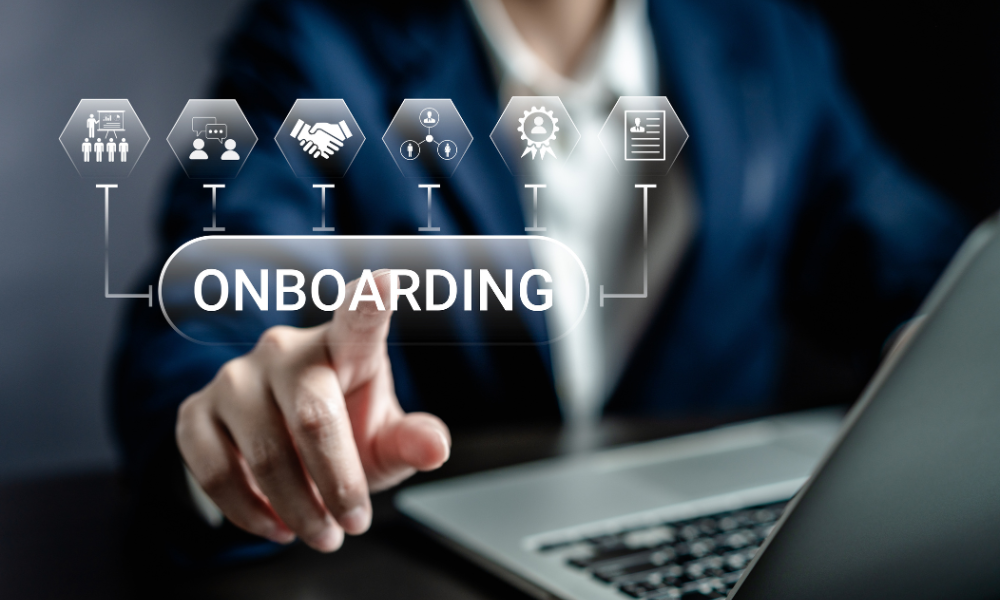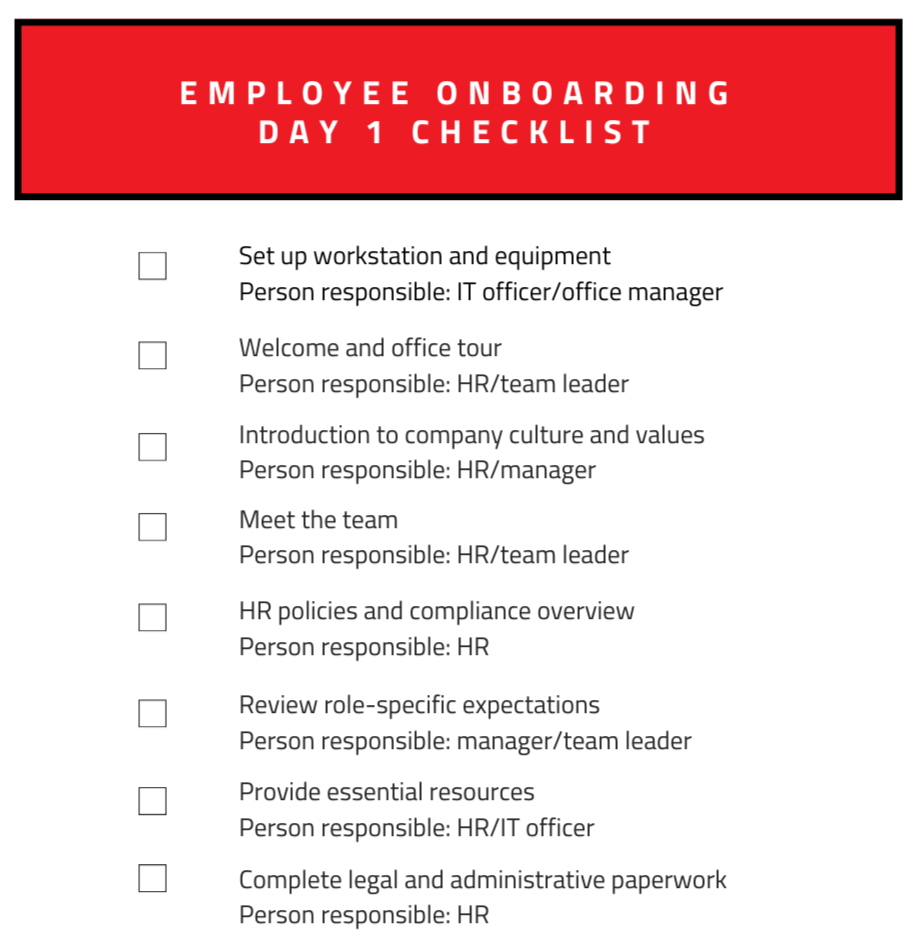
Employee onboarding is more than just paperwork. It's about creating positive moments for a new hire. Find out why a good onboarding program is worth the effort

Employee onboarding sets the tone for a new joiner’s experience with an organization. Studies show that employees who were satisfied with their onboarding experience were more than likely to be engaged and happy in their new roles.
Yet employers don’t always get it right. According to a report, one in three employees were not happy with their onboarding experience. Some even described it as terrible.
In this article, we’ll show why an amazing onboarding process is so important. We’ll go over best practices for employee onboarding. We’ll also take a look at the wider impact – good or bad – that employee onboarding has on the company.
Employee onboarding is the process of introducing a new employee to their new role, covering points such as:
New hires are also introduced to the various aspects of their new company:
Apart from giving new hires the right amount of information and meeting compliance requirements, a good employee onboarding program offers opportunities to connect with others. The main goal is to create a positive experience for new joiners. They should feel welcome and valued.
Employee onboarding is an important part of an employee lifecycle. Employees decide within the first six months whether they will stay or leave, so a strong employee onboarding program is a must.
Employee onboarding programs may look and feel different across organizations, but the basic structure has four phases:
The onboarding process starts even before the employee’s first day. It begins at the interview stage for the job with a clear set of expectations for the applicant. HR also gives an overview of the kind of culture that the company wishes to promote and see if the candidate is a good fit.
After an offer has been made, the new hire completes and signs all required paperwork such as:

New hires must also have read and understood the workplace health and safety (WHS) policies.
Most of these documents are best completed before the employee’s first day. Others such as emergency contact information and acknowledgement of WHS policies can be done when the new hire starts work.
Make a good impression on your new hire – make sure everything is set up and ready for them on their first day of work. Here are some points to remember:
Make sure their office or desk is set up and their tech (laptop, work phone, mobile phone) are ready. Working equipment and a clean workspace let your new employee know that you’ve prepared for their arrival.
Include an office tour in their Day 1 schedule. Make sure that their team leader or colleague/buddy is available to show them around the office. This is a good opportunity for your new hire to familiarize themselves with the office and meet other staff.
Have a session with the new joiner to discuss the company’s mission, core values, and workplace culture. Consider doing that over tea or coffee for a more relaxed setting.
Discuss essential policies such as workplace health and safety, anti-discrimination, and harassment policies. Go over important points in the company handbook as well. Address any questions or concerns they might have.
Whenever possible, make sure that the team leader is in the office (or online for remote workers) on the new hire’s first day. Suggest a team lunch with the new employee to make them feel welcome. Your new hire will have a lot of questions during their first few weeks – make sure they know who to approach for help.
Set expectations on job responsibilities and performance. Talk about setting milestones and what success looks like in that role.
Go over access to employee handbooks and SOPs, keycards, passcodes, and other onboarding materials.
Most of the required paperwork should be signed by now, so go over anything else that needs to be completed.
Here’s a quick look at what Day 1 might look like:

If you’re planning to onboard a team that works at home, here’s a guide to onboarding remotely.
Some onboarding programs involve a mix of online and in-person activities. The Redland City Council, for example, uses online forms to gather information on its new hires and organizes face-to-face induction days.
Find out more about Redland City Council’s onboarding program in our special report on the best HR teams for innovation.
Training is an important phase in the onboarding process. It helps employees build the skills and confidence to perform their best in their new roles. Training programs, if done well, can be good employee retention tools for the company.
Here are some types of training for your new joiners:
Role-specific training: covers everything the employee needs to know about their new job
Technical skills training: sessions on learning how to use software and equipment
Compliance training: refers to training on workplace health and safety, anti-harassment, and other areas mandated by law
Mentorship/buddy system: aside from imparting knowledge and skills, this system helps build ties between the new hire and other employees
Job shadowing: allows the new employee to learn various areas of the job, whether it’s within or outside their department
Include a blend of classroom, online, and hands-on training to appeal to different learning styles.
The final stage of employee onboarding is integration, where employees transition from new hires to more confident and productive team members.
Continue to keep new hires enthusiastic and engaged at this phase. Quick and regular check-ins would be good, just to see how they’re doing.
To continue building on their skills and knowledge, encourage new hires to:
You might want to organize social activities at this stage to help your new hire fit in. Some ideas to consider:
team-building lunches or dinners: a chance to bond with others and make friends at work
after-work socials: monthly events like trivia nights or happy hour to foster team bonding
group workshops: interactive sessions that combine learning and socializing
peer-led coffee chats or virtual hangouts: these could be small group meet ups – perfect for introverts!
Looking for other creative ways to do your onboarding process? Find out how these three companies tried new ways to onboard.
According to a Gallup study, it takes a new employee around a year to fully settle into the role and perform at their best.
In reality, the length of employee onboarding programs varies across organisations. In a recent survey, 62% of employees said that their onboarding was completed within a week. Seven percent said there was no onboarding program at all!
Here’s the rest of the findings:
The onboarding process should be made up of initial intensive activities and more periodic long-term assessments, meetings, and re-evaluations.
Longer-term activities will help employees retain key information. An extended onboarding period will also give them the opportunity to ask questions and raise potential concerns.
Activities that can be extended to the one-year mark include:
Long-term development plans structured around the essential learning and performance needs of a new employee
additional learning programs that provide a sense of achievement for new employees
surveys at different points – every three months, for example – during the first year to get feedback from employees
mentoring programs that link up new employees with a like-minded mentor who can deliver more personal advice and emotional support during the first year
social and networking events to connect new hires with other staff across the company
An extended onboarding is one of the five steps for an effective onboarding process.
Over the years, and especially since the pandemic, technology has been playing a greater role in the onboarding process.
Software portals are a useful tool for new employees. They can help employees keep track of goals, expectations and deadlines. They can also help team leads and managers check that all new employees are up to speed as far as the onboarding process goes.
Software and e-learning are a great way to streamline the onboarding process, allowing HR teams to focus on more personalized onboarding strategies.
If you’re looking for the best tools for employee onboarding, take a look at the leading HR software vendors in Australia and New Zealand. These are the industry’s top names across 12 key service areas such as reward and recognition, workforce management, and L&D.
One simple way of making new hires feel welcome is to make them feel special.
Most onboarding programs, unfortunately, focus on policies than people. In a 2024 survey of 1,000 employees worldwide, more than half said that their onboarding experience revolved around paperwork and policies. Less than 50% mentioned being in activities that focused on building connections with their colleagues.
It’s time for organizations to evaluate how they do employee onboarding. While paperwork is required for legal reasons, that’s not just what onboarding is about. It’s also about offering a personalised onboarding experience to make the new joiner feel engaged and motivated.
The 2024 State of Employee Onboarding Report talks about ‘wow!’ moments in an employee’s onboarding experience. They’re defined as 'experiences that made you feel valued as a person and super excited to be in the role.' Some examples are:
Welcoming new team members is a special moment, and there’s no better way to make them feel at home than with a thoughtfully curated new hire kit! 🎉Show your team they're valued on day one with branded essentials that are perfect to start their journey! ✨ pic.twitter.com/11njWR9fpd
— Boost Engagement (@boostengage) October 11, 2024
Taking these small steps for your new hire will pay off. Employees who had these ‘wow!’ moments were more likely to say that:
How does this affect your company’s bottom line? Happy employees stay longer on the job, saving you thousands in recruitment and hiring costs.
While it’s vital to integrate a new employee into the organization, giving them an opportunity to share their goals and vision is just as important.
Simply having that conversation will make an employee feel respected and that their own values matter. In that way, personal motivation can be tied into the employee’s work within the organization.
Schedule performance reviews at 30, 60, and 90 days. This rhythm gives a new hire opportunities to reflect on what they’re doing well and what they could do better.
Performance reviews shouldn’t only be about assessing an employee’s output. These reviews are opportunities for the employee to reflect on what the organization can do to help them achieve their goals. Frame these performance reviews as constructive, two-way chats, empowering your new hire to take charge of their own development.
Employee onboarding is so much more than collecting paperwork from a new hire. It’s about making them feel welcome and giving them the tools they need to succeed in the role.
While paperwork and policies are important from a compliance point of view, other factors add deeper value to a new joiner’s onboarding experience. Meaningful connections with others, the opportunity to contribute, and wow moments are just a few examples.
An amazing employee onboarding experience has a lasting effect beyond the first few weeks on the job. The feeling of being valued, engaged, and confident stays with employees throughout their career with the company. They feel happy and satisfied at work, giving them every reason to stay.
Do you think it’s time to review your company’s employee onboarding process? Let us know in the comments below